Related Research Articles

The Legend of Zelda is an action-adventure game franchise created by the Japanese game designers Shigeru Miyamoto and Takashi Tezuka. It is primarily developed and published by Nintendo, although some portable installments and re-releases have been outsourced to Flagship, Vanpool, and Grezzo. The gameplay incorporates action-adventure and elements of action RPG games.
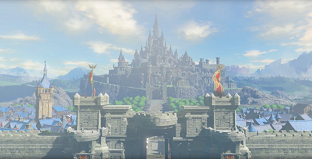
The Legend of Zelda is a video game franchise created by Japanese video game designers Shigeru Miyamoto and Takashi Tezuka and mainly developed and published by Nintendo. The universe of the Legend of Zelda series consists of various lands, the most predominant being Hyrule. The franchise is set within a fantasy world reminiscent of medieval Europe which consists of several recurring locations, races and creatures. The most prominent race in the series are the Hylians, a humanoid race with elfin features identifiable by their long, pointed ears. The series' lore contains a creation myth, several fictional alphabets, the most prominent being Hylian, and a fictional universal currency, the rupee. Most games in The Legend of Zelda series follow a similar storyline, which involves the protagonist Link battling monsters to save Princess Zelda and defeat a villain, which is often the series' main antagonist, Ganon. Nintendo developed the series' lore into a timeline that spans thousands of years across its history.

Final Fantasy Adventure, known in Japan as Seiken Densetsu: Final Fantasy Gaiden or simply Seiken Densetsu, and later released in Europe as Mystic Quest, is an action role-playing video game developed and published by Square for the Game Boy. It is a spin-off of the Final Fantasy series and the first game in the Mana series.

The Family Computer Disk System, commonly shortened to the Famicom Disk System or just Disk System, is a peripheral for Nintendo's Family Computer home video game console, released only in Japan on February 21, 1986. It uses proprietary floppy disks called "Disk Cards" for cheaper data storage and it adds a new high-fidelity sound channel for supporting Disk System games.
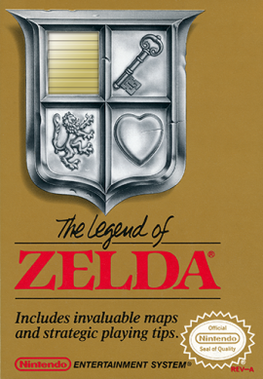
The Legend of Zelda, originally released in Japan as The Hyrule Fantasy: Zelda no Densetsu, is an action-adventure game developed and published by Nintendo. The first game of The Legend of Zelda series, it is set in the fantasy land of Hyrule and centers on an elf-like boy named Link, who aims to collect the eight fragments of the Triforce of Wisdom in order to rescue Princess Zelda from Ganon. The player controls Link from a top-down perspective and navigates throughout the overworld and dungeons, collecting weapons, defeating enemies and uncovering secrets along the way.

The Legend of Zelda: A Link to the Past is an action-adventure game developed and published by Nintendo for the Super Nintendo Entertainment System. It is the third game in The Legend of Zelda series and was released in 1991 in Japan and 1992 in North America and Europe.
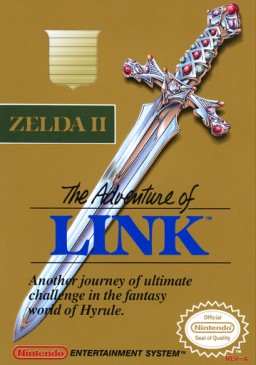
Zelda II: The Adventure of Link is an action role-playing video game with platforming elements developed and published by Nintendo. It is the second installment in the Legend of Zelda series and was released in Japan for the Famicom Disk System on January 14, 1987—less than one year after the Japanese release and seven months before the North American release of the original The Legend of Zelda. Zelda II was released in North America and the PAL region for the Nintendo Entertainment System in late 1988, almost two years after its initial release in Japan.

The Satellaview is a satellite modem peripheral produced by Nintendo for the Super Famicom in 1995. Containing 1 megabyte of ROM space and an additional 512 kB of RAM, Satellaview allowed players to download games, magazines, and other media through satellite broadcasts provided by Japanese company St.GIGA. Its heavy third-party support included Squaresoft, Taito, Konami, Capcom, and Seta. To use Satellaview, players purchased a special broadcast satellite (BS) tuner directly from St.GIGA or rented one for a six-month fee. It attaches to the expansion port on the bottom of the Super Famicom.

Link is a character and the protagonist of Nintendo's video game franchise The Legend of Zelda. He was created by Japanese video game designer Shigeru Miyamoto. Link was introduced as the hero of the original The Legend of Zelda video game in 1986 and has appeared in a total of 20 entries in the series, as well as a number of spin-offs. Common elements in the series include Link travelling through Hyrule whilst exploring dungeons, battling creatures, and solving puzzles until he eventually defeats the series' primary antagonist, Ganon, and saves Princess Zelda.

Ganon is a character and the main antagonist of Nintendo's The Legend of Zelda video game series and franchise, as well as the final boss in many Zelda titles. In his humanoid Gerudo form, he is known as Ganondorf. A massive and malevolent pig-like creature, Ganon first appeared in the original The Legend of Zelda game in 1986, while his alter ego, Ganondorf, was introduced in Ocarina of Time. He has since appeared in the majority of the games in the series in various forms. He is the archenemy of the protagonist Link and Princess Zelda of Hyrule and originally the leader of the Gerudo, a race of humanoid desert nomads before becoming the ruler of his demon army.
LCD games are electronic games played on an LCD screen. Since the release of the Zelda Game & Watch game in August 1989, several LCD games based upon the theme of The Legend of Zelda have been licensed by Nintendo to be released for both Japanese and foreign markets. While Zelda was both developed and manufactured by Nintendo, later LCD games would only be licensed by Nintendo. The Legend of Zelda game watch is an LCD wristwatch game produced by Nelsonic as part of their Nelsonic Game Watch series, and Zelda no Densetsu: Kamigami no Triforce is an LCD fighting video game licensed by Nintendo and produced by Epoch Co. for the Barcode Battler II platform, and released only in Japan.

The Legend of Zelda: Hyrule Historia is a collector's book about Nintendo's The Legend of Zelda series, published in English by Dark Horse Comics. The 276-page book reveals the official timeline of the fictional events in the series, following years of speculation by fans. The book also includes artwork for the games, a short manga, and a foreword and afterword written by the series' producers. It is the first in an official trilogy of art books known as the "Goddess Collection" that was published by Dark Horse in partnership with Nintendo and was completed by the publication of The Legend of Zelda: Art & Artifacts and The Legend of Zelda Encyclopedia. Hyrule Historia topped Amazon.com's list of bestselling books in February 2013 and was Amazon's sixth best-selling print book of 2013.
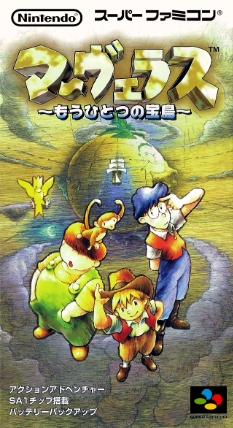
Marvelous: Mōhitotsu no Takarajima is a video game for the Super Famicom. It is the first title directed by Eiji Aonuma, and was published and released exclusively in Japan by Nintendo. Two special versions of the game, BS Marvelous: Time Athletic and BS Marvelous: Camp Arnold were released for the Satellaview.

The Minus World is a glitched level found in the 1985 video game Super Mario Bros. It can be encountered by maneuvering the protagonist, Mario, in a particular way to trick the game into sending him to the wrong area. Players who enter this area are greeted with an endless, looping water level in the original Famicom/NES cartridge versions, while the version released for the Famicom Disk System sends them to a sequence of three different levels; this difference is due to the data being arranged in different ways between the two versions. It gained exposure in part thanks to the magazine Nintendo Power discussing how the glitch is encountered. Super Mario Bros. creator Shigeru Miyamoto denied that the addition of the Minus World was intentional, though he later commented that the fact that it does not crash the game could make it count as a game feature.

King Kong 2: Yomigaeru Densetsu is a 1986 MSX2 role-playing video game by Konami. It was released only in Japan and based on the movie of the same year, King Kong Lives. Similar to Konami's later Hi no Tori games, two separate games were developed together and released for the MSX and Famicom respectively. While the Famicom King Kong 2: Ikari no Megaton Punch has players playing as King Kong in a more action-oriented format similar to Nintendo's The Legend of Zelda, Yomigaeru Densetsu has players playing as Mitchell in a role-playing style.

Between August 6, 1995 and May 30, 1999, Nintendo, in collaboration with St.GIGA, broadcast three different The Legend of Zelda titles to fans for download via the Super Famicom's Satellaview subsystem. BS Zelda no Densetsu, BS Zelda no Densetsu: MAP2, and BS Zelda no Densetsu: Inishie no Sekiban all featured SoundLink narration which was the first time that Nintendo-sponsored Zelda titles made use of voice-actors to provide vocal tracks. As the first SoundLink Game released via Satellaview, BS Zelda no Densetsu in particular was identified by Nintendo as the world's first integrated radio-game. Also broadcast during this time, starting on March 2, 1997, was a non-SoundLink port of The Legend of Zelda: A Link to the Past, known as Zelda no Densetsu: Kamigami no Triforce in Japan. Broadcasts of Kamigami no Triforce continued periodically throughout the tenure of Nintendo's partnership with St.GIGA, after which St.GIGA independently broadcast the game until May 29, 2000.
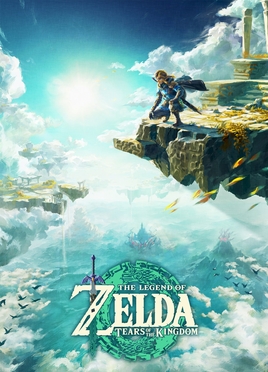
The Legend of Zelda: Tears of the Kingdom is a 2023 action-adventure game developed and published by Nintendo for the Nintendo Switch. The player controls Link as he searches for Princess Zelda and fights to prevent Ganondorf from destroying Hyrule. Tears of the Kingdom retains the open-world gameplay and setting of its predecessor, Breath of the Wild (2017), and features new environs including the sky, an area composed of floating islands, and an expansive cavern beneath Hyrule known as the Depths. The player has access to various devices that aid combat or exploration, and which can be used to construct vehicles.
References
- ↑ Nintendo Co., Ltd (February 21, 1986). The Hyrule Fantasy: Zelda no Densetsu (Famicom Disk System) (in Japanese). Nintendo.
- ↑ Nintendo (August 6, 1995). BS Zelda no Densetsu (Satellaview) (in Japanese) (Aug 95 ed.). St.GIGA.
- 1 2 Mejia, Ozzie (21 February 2021). "It's Dangerous to Go Alone: 35 Years of The Legend of Zelda". Shacknews. Retrieved 2021-11-27.
- ↑ The Legend of Zelda Instruction Booklet (PDF). Nintendo. 1987. p. 41.
- 1 2 Wilde, Tyler (2012-06-23). "The 40 most repeated game quotes". GamesRadar . p. 2. Retrieved 2014-05-03.
- ↑ ""It's Dangerous to Go Alone!" - #22 Top Video Game Moments". IGN . Retrieved 2014-05-03.
- ↑ "The 100 best video game quotes of all time". GamesRadar . 2013-05-30. Retrieved 2014-05-03.
- ↑ Donlan, Christian (2023-08-19). "Who really told Link it's dangerous to go alone?". Eurogamer.net. Retrieved 2023-11-22.
- ↑ "The Legend Of Zelda 35th Anniversary: Our Favorite Games And Why". GameSpot. Retrieved 2021-12-13.
- ↑ "Then & Now: Exploration in The Legend of Zelda". NF Magazine (25): 54. January 2024 – via Internet Archive.
- ↑ Kohler, Chris. "Lost in Translation: This Game Are Sick". Power-Up: How Japanese Video Games Gave the World an Extra Life. BradyGames. p. 215.